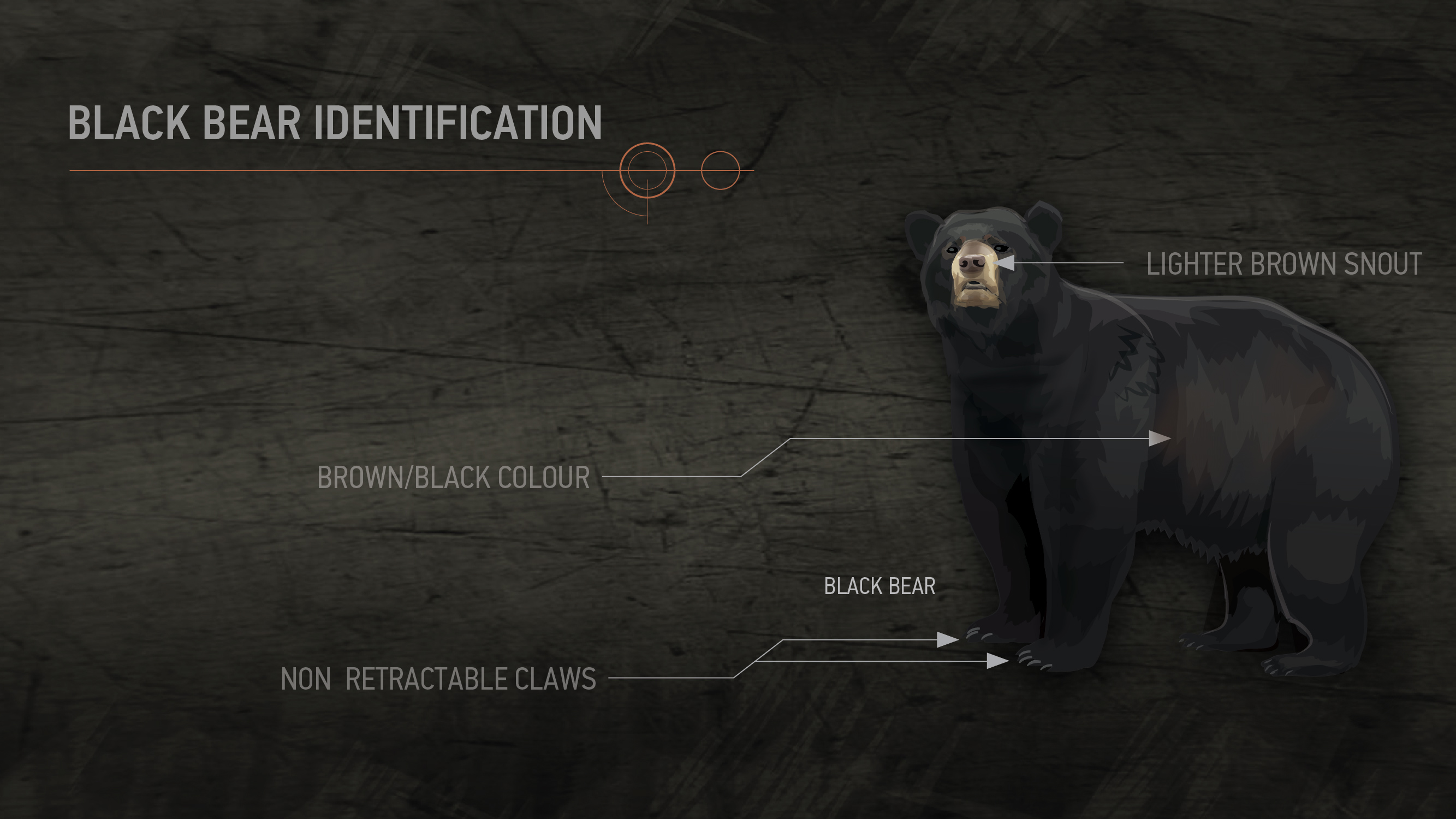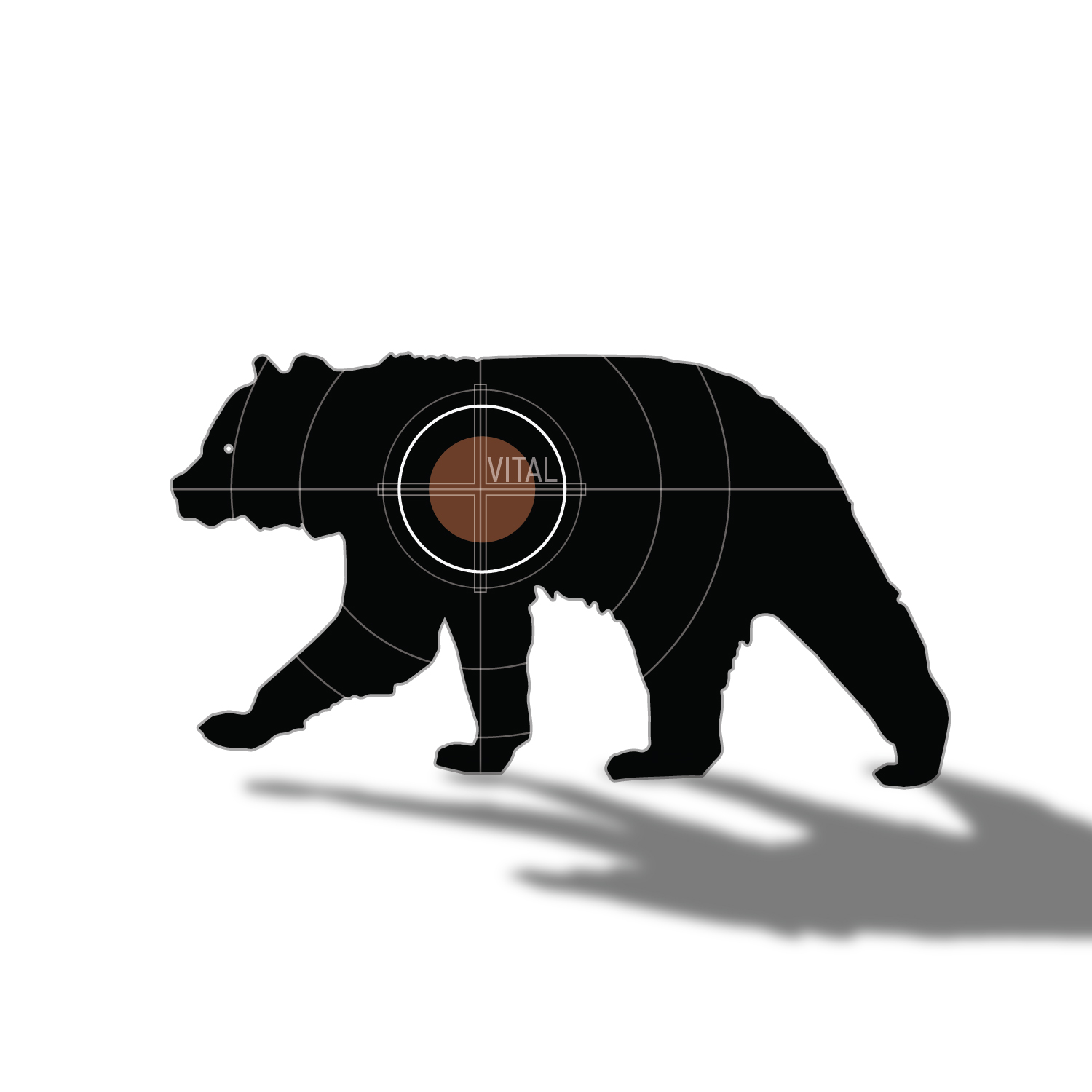HUNTINGsmart! USA Knowledge Base
Module 10 - WILDLIFE
BEARS

It takes a firearm/ammo combo with muscle to bring down a black bear and a hunter with muscle to drag a bear carcass out of the woods. Are you up to the task?
Identification
The smallest of the three bear species found in North America, black bears are expert tree climbers with short, non-retractable claws. So, if you’re trying to escape an attacking black bear, do NOT climb a tree.
Black bear fur is a brownish-black color except on the snout, which is a lighter brown color. The weight of a black bear can fluctuate widely depending on the time of year. Just prior to hibernation, black bears will accumulate large fat reserves and weigh up to 60% more than they would during the summer months. Male black bears can weigh between 250-600 lbs. and the females are slightly smaller weighing between 100-400 lbs (again, depending on the time of year). Remember, although females are smaller and they may appear more cautious than males when entering bait sites, they can be very aggressive if they have cubs with them… so watch out for protective mama bears.
Adult females are smaller and leaner looking, they have elongated muzzles, flatter looking foreheads and bigger looking ears. They also have a tuft of gathered hair angling down and outward from the vulva, which is immediately below the tail. They also have enlarged mammaries when nursing and have a visible vulva when they’re ‘in heat’ (heat season peaks in June).
Adult males tend to have blockier bodies, big-looking front feet and they have wider, rounder and more muscular heads, necks and shoulders. Their ears look smaller and further apart and there is usually a crease or furrow that runs down the centre of their forehead. They also have a penis sheath that hangs down in front of the hind legs and visible testicles between their hind legs.
Black bears differ from their bigger cousin (the grizzly) in the following ways: Black bears are darker in color, they have a straighter facial profile, they’re smaller in size and they lack the distinctive shoulder hump of the mighty grizz.
Diet
Black bears hibernate in the winter. This means they eat a TON of food during the rest of the year. These omnivores are major scavengers and will eat just about anything. They prefer to munch on berries, seeds, acorns, fish and insects, but given the opportunity, they will also feed on small animals including young moose or deer. You may even see black bears digging through garbage at a dump or in the garbage bin at your cabin. It’s really quite simple with these guys: Food source = black bear. Think about it—in the spring, they’re just waking up from a really, really long nap so they’ll be starving and looking for chow. They’ll spend the rest of their wakeful year packing on the pounds they’ll need to carry them through their winter slumber.
Habitat
Black bears are big, solitary animals that hang out in well-covered areas. You’ll most likely find them in forested regions that have a variety of trees and shrubs. However, black bears are incredibly adaptable and they can be found scavenging around swamps, in mountainous areas and in fields—they’re willing to travel pretty far to fill their bellies. The home range of a male can be up to 60 square miles, whereas females will usually stick to a home range of about 15 square miles. Although males are solitary creatures, female black bears have been known to share their home range with several other females. So, if you’ve spotted a female black bear but don’t have a shot opportunity, hang tight (and look out) because there may be other female bears in the area.
Scat
Although it doesn’t look like much, finding a big blob of bear scat can provide hints about the bear’s most recent food source and the trails the bear has been travelling on. Be cautious when looking at bear scat and use a stick to poke at it—it’s full of bacteria. Look closely—if you see berries and plant tubers in it, you know that the bear has been eating salads. If the scat is darker in color and stronger-smelling, it means they’ve been eating meat. Additionally, the freshness of the scat can indicate how close the bear may be to your location. Is the scat covered in flies? Are the plants underneath it still green? If so, be alert—that bear scat is fresh and the bear may be nearby.
Trail Markings and Tracks
Bears literally leave a wake behind them when they move. They scrape, bite and rub themselves on trees to mark their territory, sometimes even marking the same tree multiple times. They’ll also flip logs and rocks over when they’re on the search for food. It’s not an undisturbed looking trail, that’s for sure. Remember to look up high for markings too—black bears are serious climbers and they dig their claws deeply into the bark of trees as they climb.
Black bear paw prints look like a blockier version of a human footprint, but with an obvious space between each toe and dot imprints where the claws are. Bears have large, flat-footed paws and their largest toe is located on the outside of their foot. Finding bear tracks isn’t that difficult—their heavy body weight causes them to sink into the ground so there is usually a clear trail to follow.
Firearms, Ammo & Your Target
A black bear can be killed quickly with the same firearm/ammo combo that’s used for deer hunting—big game gear. However, your ammo requirements can vary depending on the size of the bear. Generally, you should use a .25 calibre at minimum, but most hunters will use a .30 calibre or higher due to the large wound these rounds will create on impact. You’ll need a bullet with major penetration power to get through the thick muscle and fat of a bear. Keep in mind that bears should not be hunted from long range—shoot from a distance of 200 yards or less to ensure shot accuracy.
Vital Zones




